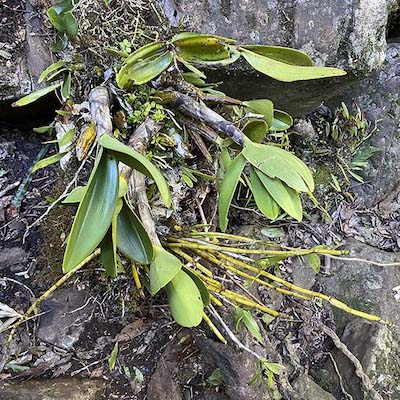Environment
Native epiphytic or lithophytic orchids are found growing naturally in most of the moist humid areas on the east coast of Australia so it is relatively easy to provide suitable conditions for growing these species. Of the two most popular genera, dendrobiums prefer bright filtered light, 50%-70% shade cloth being ideal otherwise a tree or similar screen allowing dappled sunlight will suffice. Sarcochilus are usually found in more heavily shaded areas, so up to 90% shade and somewhat cooler and more humid conditions than for dendrobiums is generally preferred.
Temperature
SE Qld temperatures are usually fine for native orchids. Good air movement is important for most kinds, especially during the hottest or coldest periods. Natural airflow should not be impeded. Sarcochilus tolerate temperatures up to 30° C. Providing more shade and air movement whilst maintaining humidity by damping down the growing area when the temperature exceeds this will allow them to maintain health through the worst of summer. Protect against extreme cold during winter by giving them some overhead protection.
Watering & Fertilising
Perfect drainage is important as many Australian Native Orchids grow on trees or rocks and dry off quickly after rain. Water thoroughly then allow plants to dry out completely before rewatering. Water regularly in summer during active growth and sparingly in winter when the plants are at rest. If you receive regular winter rain, a solid roof over plants may be necessary to prevent over-watering in the cold conditions. Fertilise regularly, especially during the growing season, using a fertiliser for flowering plants, i.e. low in nitrogen and high in potassium.
Compost
The growing media should be free draining whilst slightly retentive of moisture. A coarse bark mix is ideal, add perhaps 20% gravel, perlite or similar if you wish. The heavier media lends some weight and stability when growing in pots. As a guide, use 10 mm bark in 100 mm pots, 15 mm bark in 150 mm pots and 20 mm bark in 200 mm pots or bigger. If established in the garden, a gravel bed under the plant will help with drainage or attach firmly to a tree or rock and tie a pad of coconut fibre or similar over the root mass.
Repotting
Dendrobiums are best done soon after flowering, at the beginning of the growing season. Leave Sarcochilus till March/April after the worst of the hot weather has passed. Sarcs grow all year but experience most growth during Autumn/ winter. Ensure pots have adequate drainage and are just big enough to contain the root system of the plant to be potted.
Pests and Diseases
Scale, aphid or spider mite can sometimes attack hardy and resilient Australian Native Dendrobiums and Sarcochilus. Treat with a recommended insecticide such as Diazinon or Pest Oil. Fungal infections are rare provided good air movement is maintained during wet weather.

